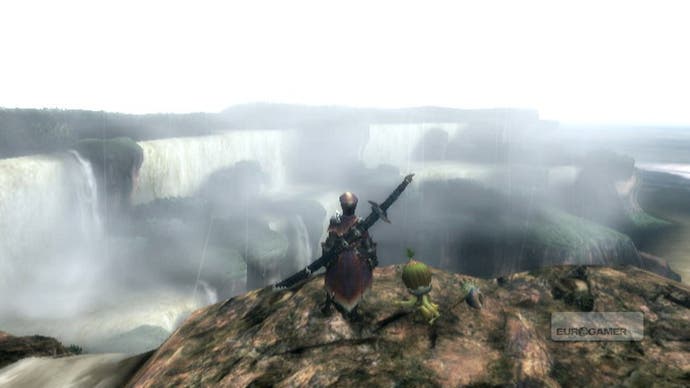Monster Hunter Tri
Tri bien.
The first thing that you notice about Monster Hunter Tri isn't the high-standard graphics or new-and-improved tweaked battle controls, oh no - it's the fact that everybody appears to be wandering around in assless chaps and thongs. The game's opening sequence depicts a typically idyllic Monster Hunter village, all carefree music and dancing, behatted cats and strong men carrying enormous fish and pails of water and farming equipment around on their muscular backs, but all of them are showing off a bit of cheek. Your character, once created, starts off in a crop top and hotpants. Like its predecessors, and refreshingly for a series of such lineage, the game better known as Tri doesn't take itself remotely seriously. It has a surreal sense of humour and an eye for visual comedy, evident in everything from outlandish armour sets to the absurd barbecuing mini-game.
Tri has been out for a good few months now in Japan, selling a cool million so far, and is present at the Eurogamer Expo this week. Evidently Japanese sales were enough to convince someone high up at Capcom that it's worth bringing it to the US and Europe next year - that it's even worth changing the online infrastructure completely to suit our tastes, incorporating Wii Speak voice chat and dropping Japan's paid subscription model. We'll not only be getting Monster Hunter Tri in the West, which was up in the air for a long time, but we'll be getting an improved version - and having delved deep into Tri's verdant jungles, dank caves and vast oceans, I'm hopping with excitement about that.
The whole structure of the game is significantly different. You still work from a village base, picking up quests and heading out to slay monsters or gather things for cash and loot to spend on better equipment or a fancy hat or a nice lamp for your house, but it's framed in a much more natural and believable story mode than Freedom Unite's endless, dry lists of tutorials and quests. You start off exploring the nearby forest, and the game teaches you monster-hunting essentials like gathering, bug-catching, fishing, mining and basic combat by letting you explore, rather than giving you an endless, daunting list of tasks. You have to fetch a few things for people back in the village and set up a camp out in the woods for an hour or so before you're sent on proper quests; it's a vastly better way of easing people into the game, and you never feel like you're trapped in a tutorial.

The world itself is much more believable, too. There's a consistent day-and-night cycle and a realistic ecology. Monsters interact with each other, migrate around the map and respond to each other, rather than following preset behaviour patterns. Tenacious little carnivores will probably still have a go at you if they reckon you're in their territory, but they don't gang up on you for no reason and refuse to leave you alone until you stick a gunlance through their necks like they used to do. Mostly, creatures go about their own business instead of existing purely to give you aggro. You can ward off small monsters with a torch at night, but it won't work so well on a fire-breathing 50-foot dragon.
Underwater hunting, Tri's flagship New Feature, is far from gimmicky. Once you dive into the ocean, you're in another world. You can do all the same things that occupy you on dry land - forage on the sea floor, use any item you have to hand and, of course, hunt - but the extra axis of movement and the lack of visibility in dark underwater caves makes it feel subtly different.


